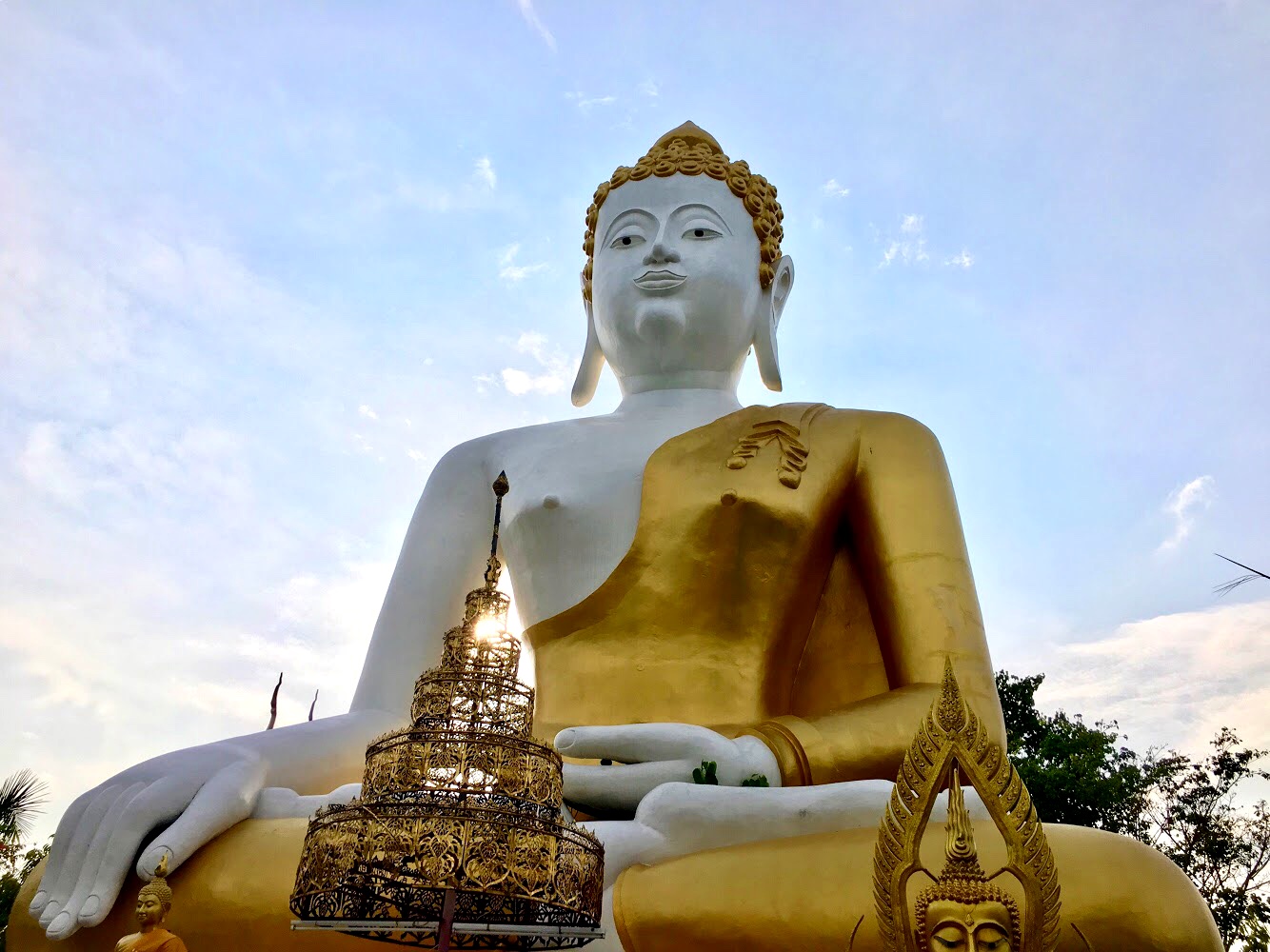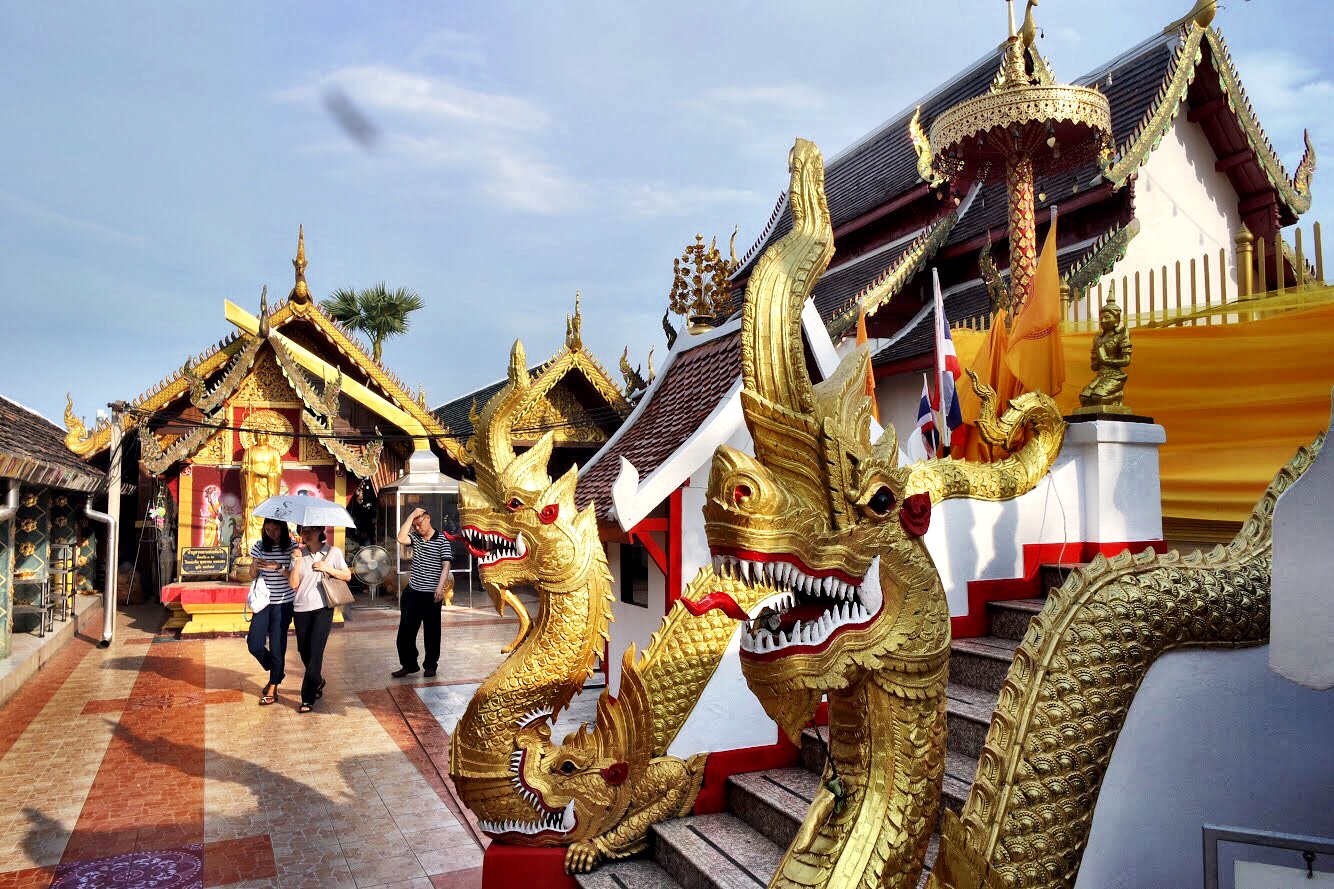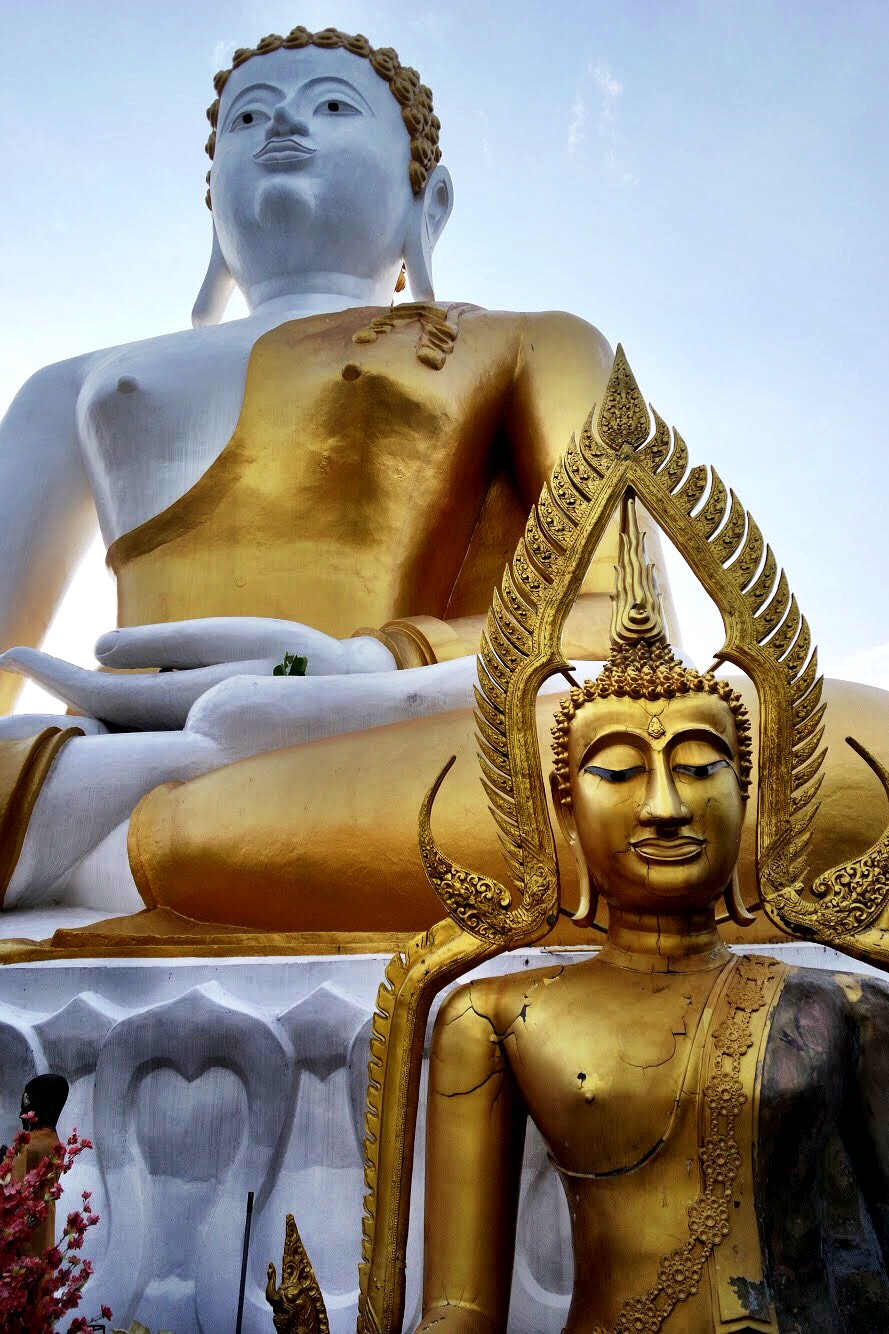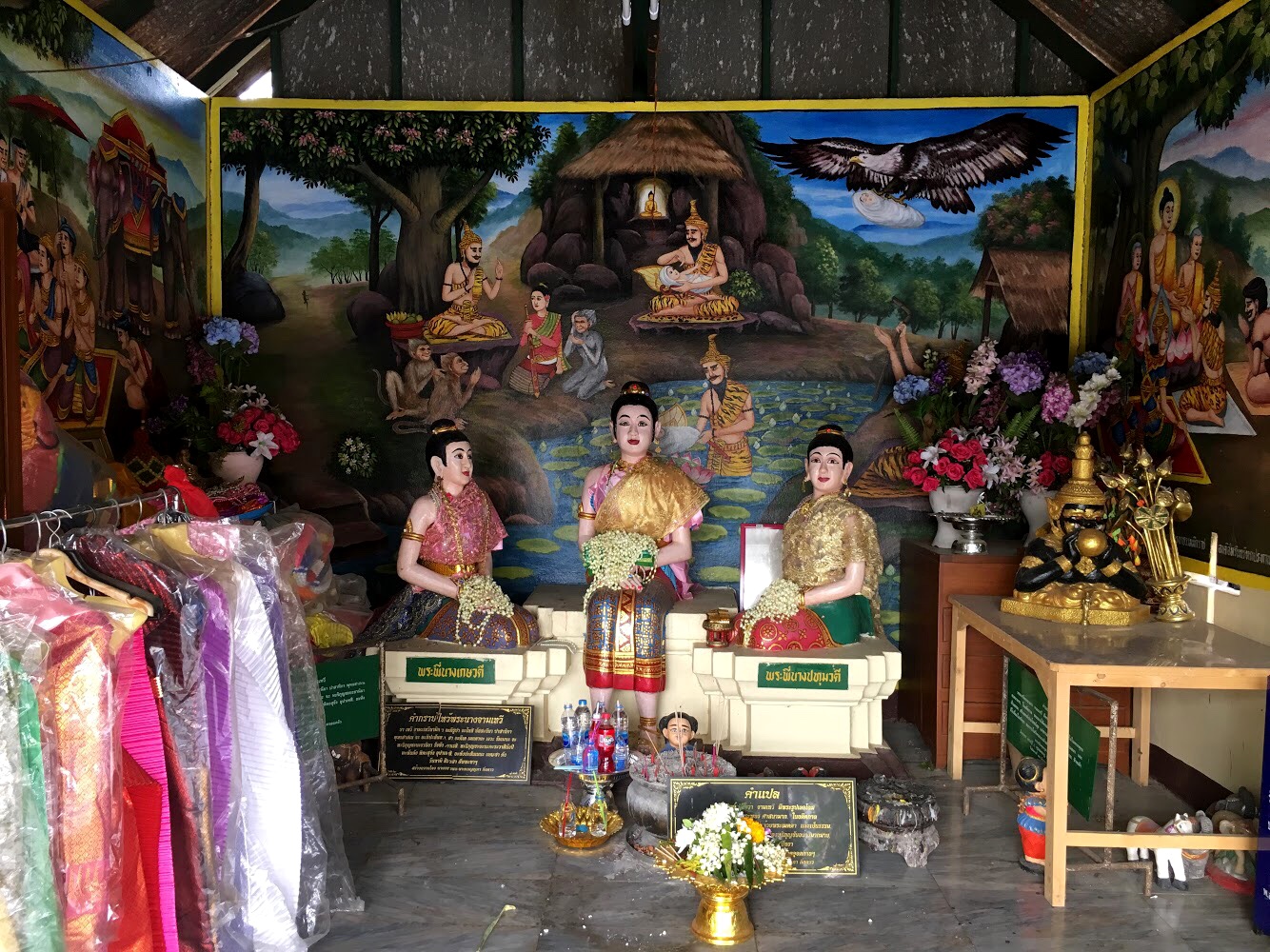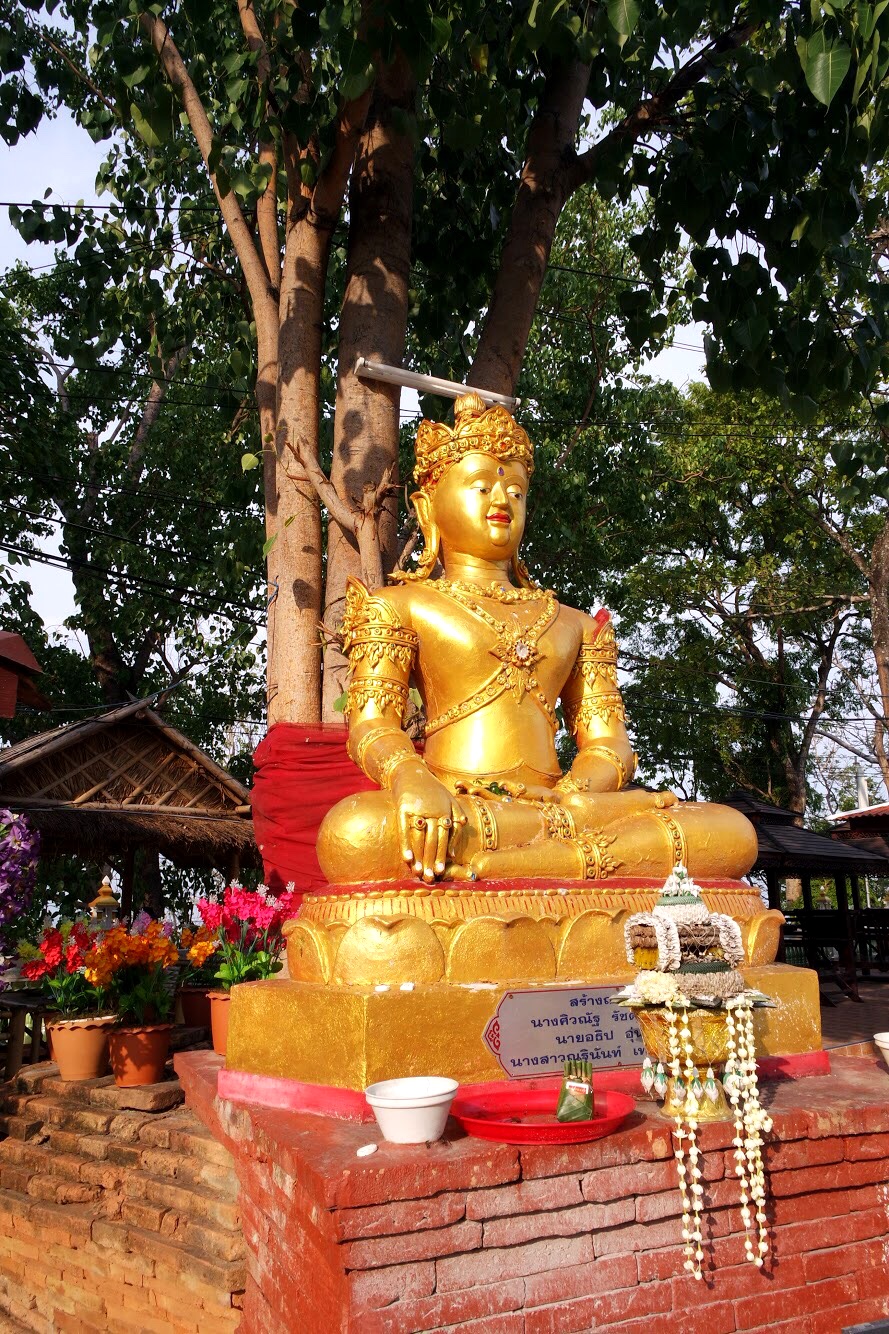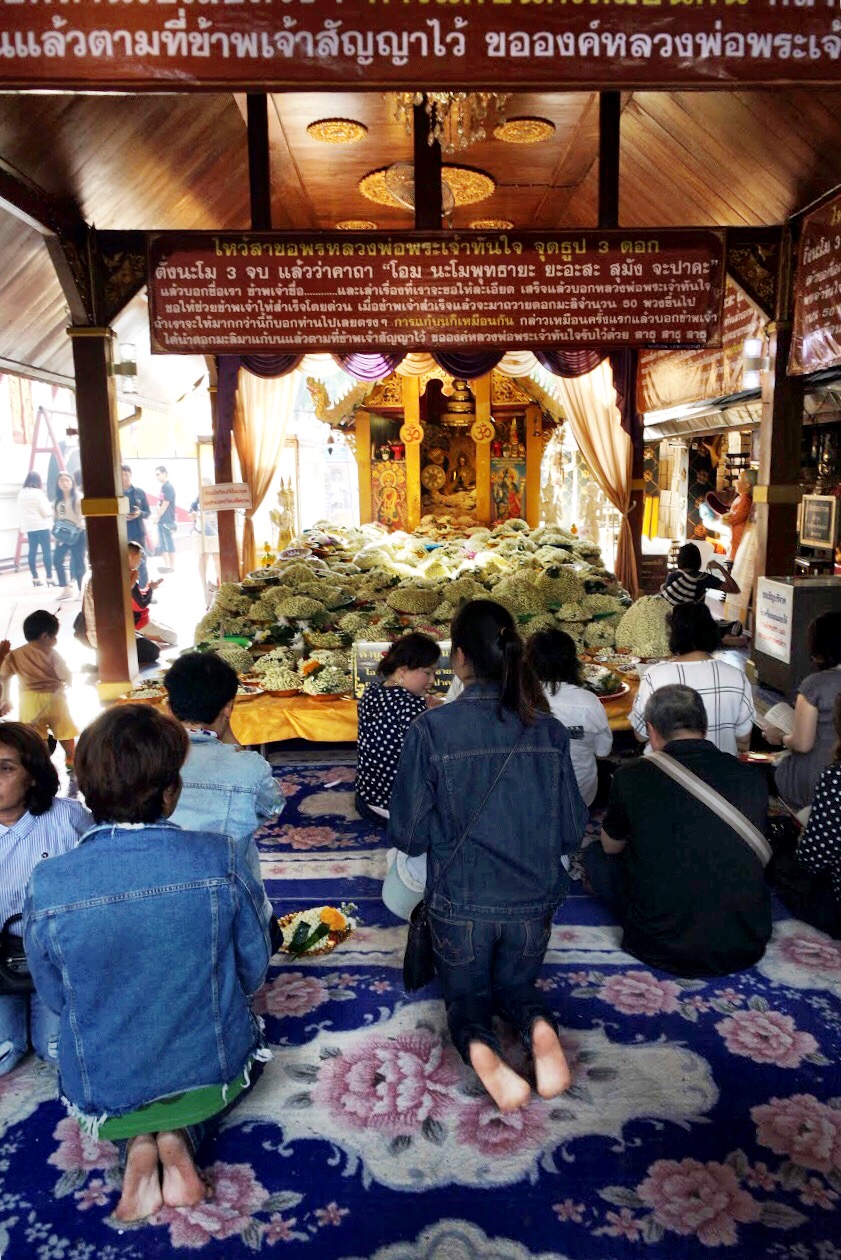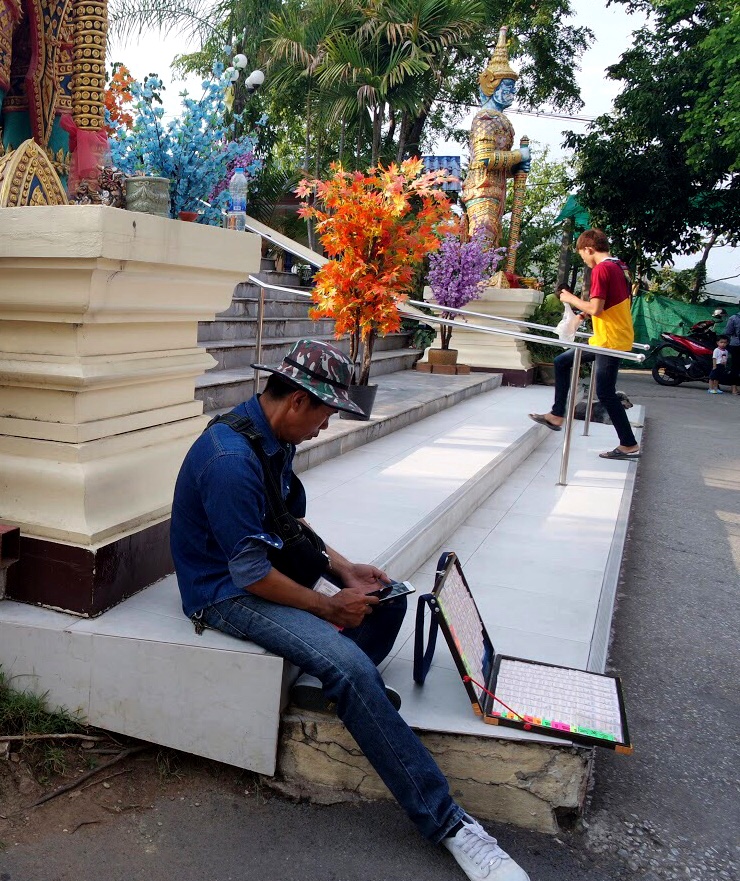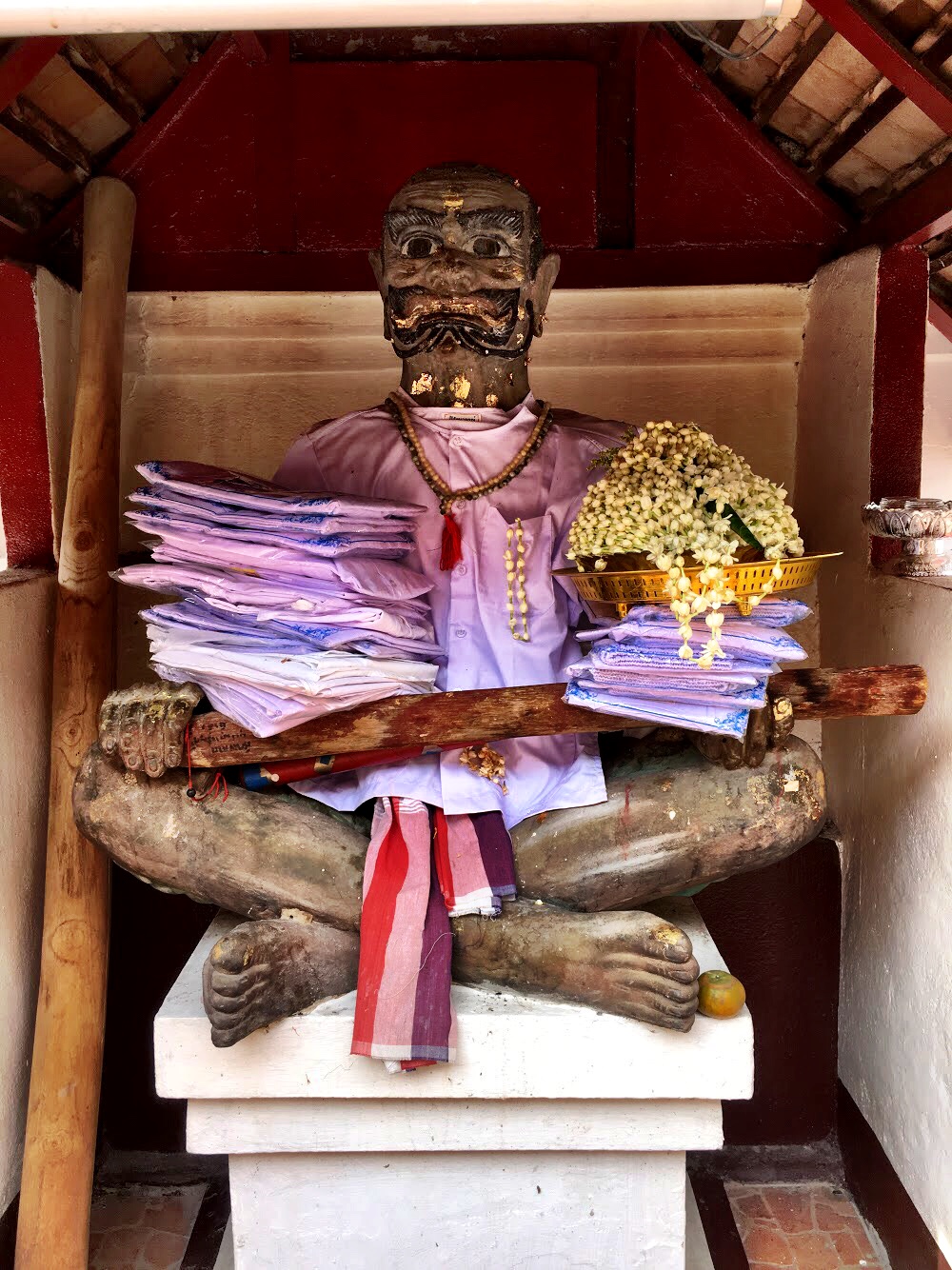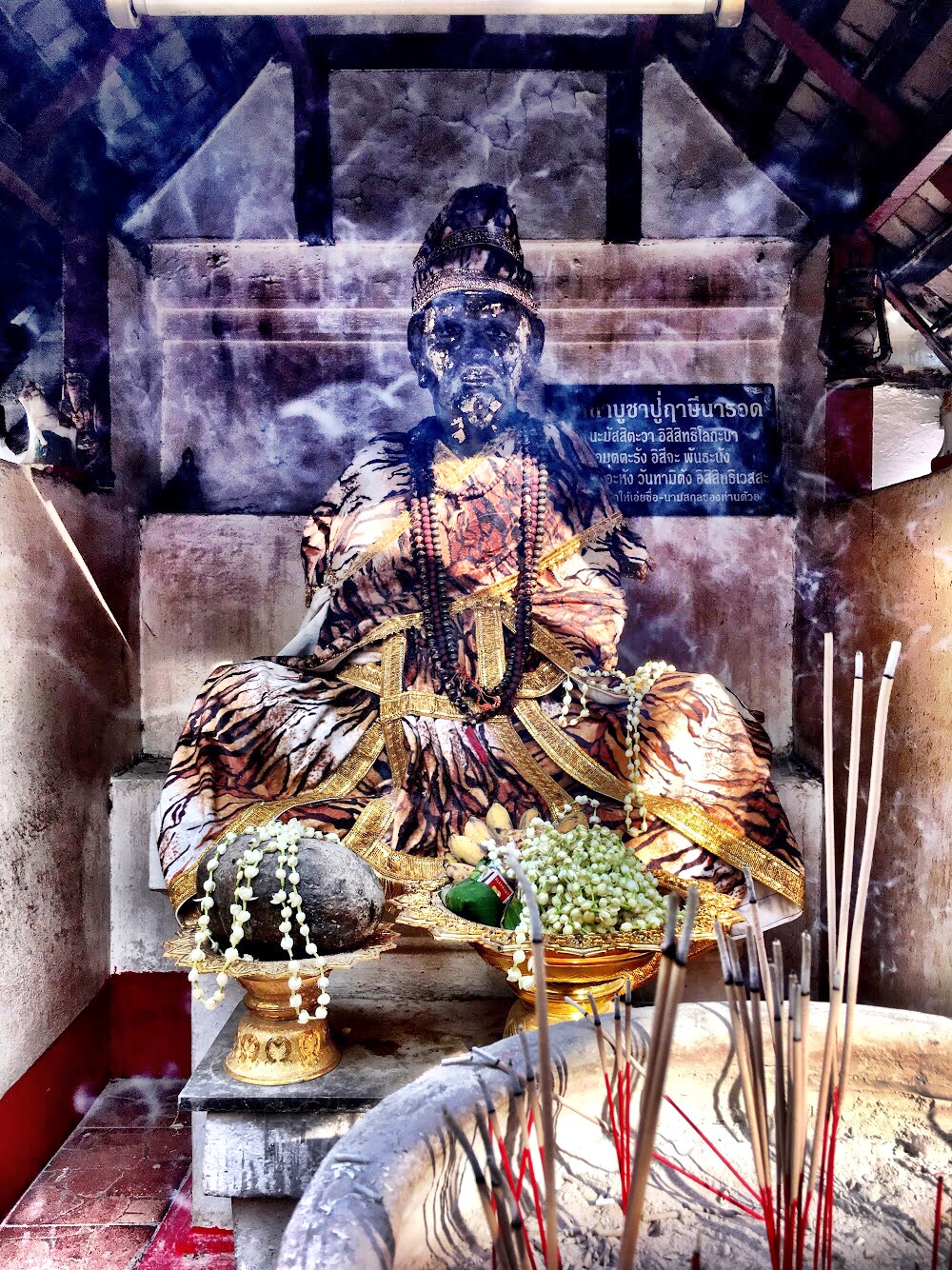Admire the big Buddha and offer flowers to have a wish come true at the Golden Mountain Temple, popular with locals and home to the giants Pu Sae and Ya Sae.
The seated Buddha at Wat Phra That Doi Kham rises over five stories high
It’s not one of the typical tourist stops, but that’s what we loved about our driver, Tommy. He got to know Duke’s and my preferences, and quickly realized we wanted to experience as many temples as we could, including those more popular with local residents than travelers.
And when Duke mentioned a folktale he had read involving two human-munching giants, Tommy knew the spot.
Just outside of the city of Chiang Mai, this temple complex is popular with locals but not with tourists
To hire Tommy as a driver — which we highly recommend — email him at t.tommy2556@gmail.com.
Gold, red and white dominate the temple, which is filled with typical Thai flourishes
Wat Phra That Doi Kham, the Golden Mountain Temple, is perched on the slopes of Mount Kham and will give you a glimpse of how a traditional Thai temple operates. Everywhere you look are small stands, pavilions and statues brightly painted white, yellow and red. There are market stalls, where you can purchase offerings and souvenirs (I bought a beaded bracelet). Numerous small shrines encircle the chedi spire.
Khun Luang Viranka tried unsuccessfully to woo the queen who built the temple — and ended up wearing her dirty panties on his head with a spear through the heart
In one of the shrines there’s a statue of a man holding a spear. This is Khun Luang Viranka, who wanted to marry Queen Chamadevi. She, along with her twin sons, are the ones who had the temple built. Chamadevi told Viranka that if he could throw his spear from Doi Suthep and into her walled city, Lamphun, 15 miles away, she would accept his proposal.
She didn’t want to marry him, though, and was concerned that he might succeed. So she sent a cursed gift to him, a hat fashioned from one of her undergarments, soiled by menstrual blood. He put the hat on, and when it came time to throw the spear, it thudded to the ground, only having traveled a measly few feet.
Distraught, he threw his spear up into the air. It came hurtling back straight down — right through his chest.
Instead of hats made of soiled panties, people offer Viranka fruit placed on a silver platter, figurines of elephants by his feet or jasmine garlands hung from his wooden spear.
The goddess of compassion, Kwan Yin, and her handmaidens accessorize with white and pink necklaces. They just can’t get enough!
There’s a shrine devoted to Queen Chamadevi, flanked by a pair of monkeys, while another features figurines of Chinese-styled women, one of whom is Kwan Yin, the goddess of compassion. These statues are weighed down with cheap beaded necklaces.
The big Buddha can be found at one end of the wat, closest to the parking area
The enormous seated Buddha statue overlooking the entrance to the temple complex is said to be the largest in the Chiang Mai area, rising 56 feet — the rough equivalent of a five-story building.
Make a Wish
The most popular offerings at Wat Phra That Doi Kham are pretty garlands of small white jasmine flowers. These, Tommy told us, are for a special part of the temple, where people pray to the Luang Por Tan Jai Buddha, the Buddha of Success, in hopes of having their wishes granted. When someone won the lottery after praying here, the temple became the go-to place to say a prayer for a quick financial windfall. And, of course, near the parking area, you’ll see numerous vendors holding what look like briefcases filled with pads of lottery tickets for sale.
Piles of jasmine garlands are offered by those who pray for a wish to come true — and by those whose wish did come true
“Dear Buddha, please let me win the lottery.”
You can spot lottery vendors by their briefcase-like containers filled with tickets
To pray to the Luang Por Tan Jai Buddha, find the crowded open-air pavilion filled with piles of flowers. State your wish, your name — and how many jasmine garlands you’ll offer after the Buddha grants your wish.
The giant Pu Sae, who reluctantly gave up eating humans so long as a water buffalo is sacrificed once a year
Ya Sae, the female giant, converted to Buddhism like her husband
Pu Sae and Ya Sae: They Might Be Giants
The oldest part of the temple is the chedi, which dates back to 687. This is where Duke’s folktale comes in. Thousands of years ago, two giants, Pu Sae, and his wife, Ya Sae, rampaged the slopes of Doi Suthep with their son, Sudeva, taking great delight in eating human flesh. (They’re typically described as cannibals, and one theory is that they were actually humans — part of the Lawa people who still live in these mountains.)
Once, when the Buddha was traveling the area, the fierce family followed his trail, intending to make a meal of him. While meditating, the Buddha became aware of their intentions, and stamped his foot into a boulder so hard it left an impression that remains to this day and has become a shrine.
This display of power terrified the giants so much, they (mostly) gave up their rapacious ways and converted to Buddhism. At first, they begged to be allowed to eat just one tasty human a year, but Buddha naturally refused. They then begged to be allowed to eat human flesh only once every seven years. They were refused again, and finally agreed that they’d settle for an annual sacrifice of a water buffalo. This gruesome practice is part of a yearly festival to ensure plentiful rain.
The Buddha plucked out one of his hairs to put inside the chedi. (Whenever you see a temple with “Phra That” as part of its name, it’s an indication that the chedi houses a relic of the Buddha.)
In some versions of the tale, the giants are actually shapeshifting Hindu demons, rakshasas, who try to eat the Buddha. He kills them with kindness, so to speak, and they revered him and swore off eating human flesh.
The giants are now said to protect the temple. They don’t do the best job, apparently, since the chedi collapsed in 1966 after heavy rains. Though, of course, that could have all been part of the plan. Ancient Buddha images were unearthed, leading to a revitalization of the temple.
Today you can find shrines to this famous couple, the gold leaf on their faces peeling off, giving them an appropriately gruesome look. Though we’re not sure why, it seems that worshippers place folded dress shirts still wrapped in plastic upon their laps as offerings. Holy shirt!
Smoke from incense gives the Hermit’s shrine an otherworldly look
The Hermit and the Queen
The giants’ son, known alternately as the Ruesi, Lersi, Suthep Hermit or Sudeva, gave up meat forever, shaved his head and became a Buddhist monk. The cave where he took up residence is atop Doi Suthep, the mountain that later took his name.
We were excited to deduce that the likeness of the bearded man wearing a tiger skin at Doi Kham (as well as at Wat Phra That Doi Suthep) was the hermit we sought.
Another shrine to the Ruesi, or Hermit, at Doi Kham. You can spot him by his tiger skin cloak
This fellow was living his solitary life, when one day he found the young princess who would become Queen Chamadevi, sitting atop a giant lotus. He raised the girl, who went on to marry a prince of the Mon kingdom in Central Thailand. The king later sent her up north to establish a new city and a sister kingdom for the Mon people, who were the first to bring Buddhism to the area.
The festive plaza that overlooks the countryside at one end of the temple
The Panoramic Overlook
The rear of the temple complex feels like a city square and offers a spectacular view of the surrounding countryside. We came from the parking lot in the opposite direction, but you can access the terrace and wat by climbing a massive stairwell lined with undulating golden nagas, the mythical serpents found everywhere in Thai architecture and iconography.
Golden naga undulate up the hill, leading to the panoramic overlook
Duke and Wally pose on the love bench on the enormous back patio
Duke and I sat on a bench beneath numerous artificial red and white roses woven into a vaguely heart-shaped arch. It was silly and sweet.
“Could you imagine anything like this at a church?” I asked Duke.
That’s part of what I love about temples. They’re places to pray, but they’re also communal spaces with an air of festivity about them.
Part elephant, part human, part bird, these creatures guard an entrance to the heart of the temple
The back patio is guarded by two strange elephant-headed, bird-legged creatures to either side of a stairway that leads to the temple.
If you’ve got some extra time in Chiang Mai and want to see a temple that’s more popular with locals (hoping to win big in the lottery), swing by Doi Kham, perhaps as part of a day trip to Doi Suthep. Just be sure to make plans to return to offer jasmine garlands if your wish comes true. –Wally
Bells and nagas fill Wat Phra That Doi Kham
Wat Phra That Doi Kham
Mu Ban Chiang Mai Lake Land Road
Tambon Su Thep
Amphoe Mueang Chiang Mai
Chang Wat
Chiang Mai 50200, Thailand

